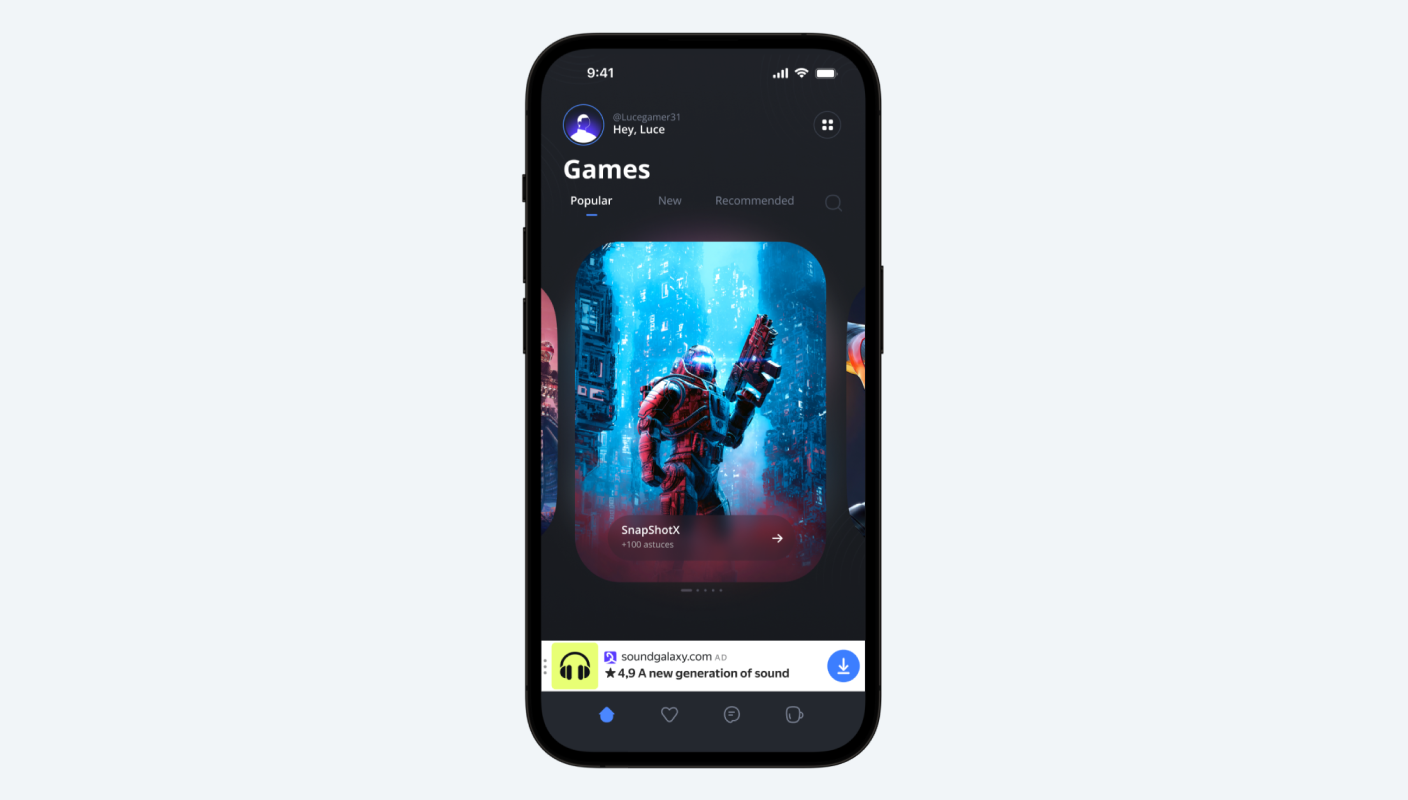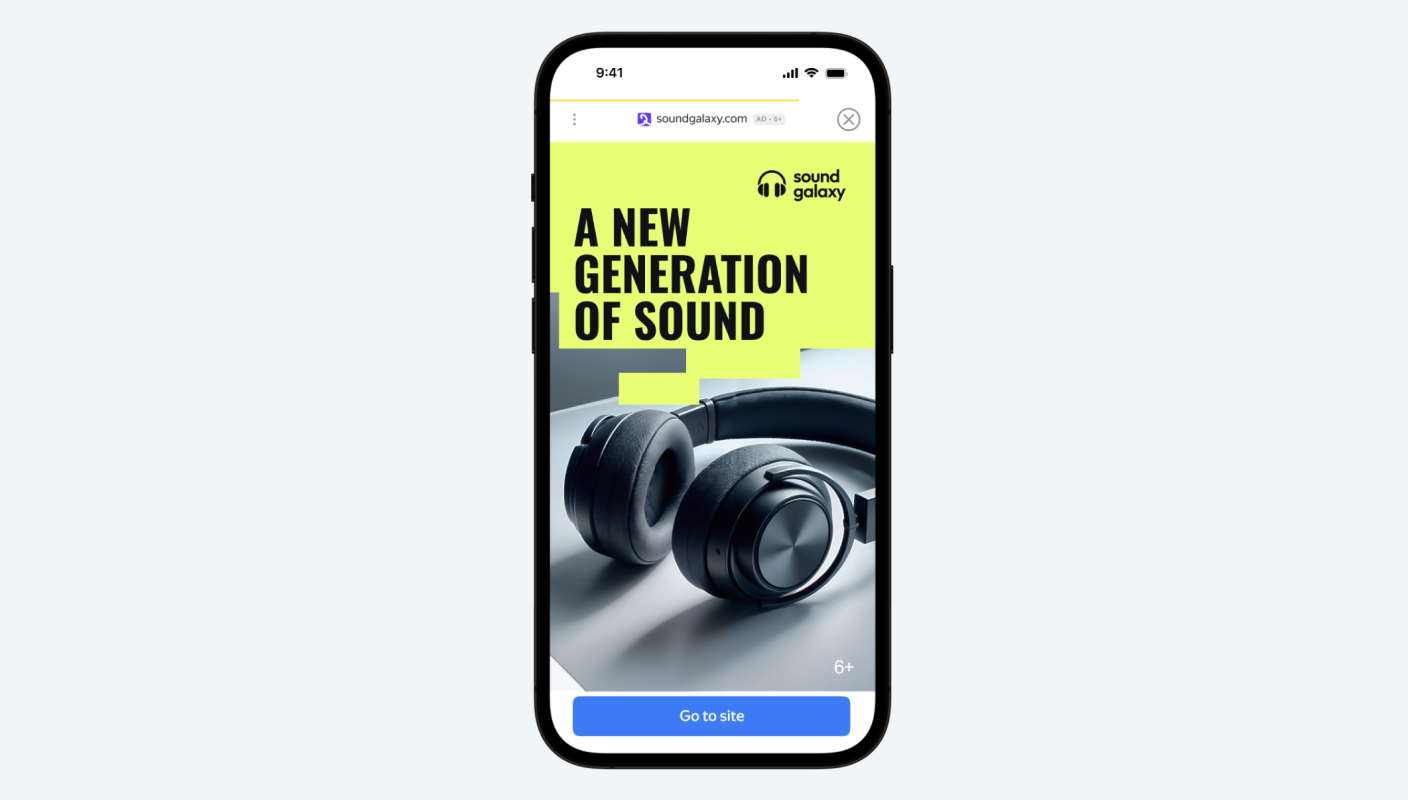Brand Advertising: 7 Proven Strategies with Real-World Examples


What is brand advertising?
Instead of chasing quick wins, brand advertising focuses on growing long-term engagement. It shapes how people feel about a brand by telling a consistent story that reflects its values and mission.
When you invest in this type of advertising, you’re building awareness, trust, and loyalty – the things that make people come back again and again. Over time, a strong, steady message helps your brand feel familiar, relatable, and memorable, making a real impact on future decisions.
For example, Coca-Cola’s "Share a Coke" campaign didn’t push sales. It celebrated personal connections, boosting brand image and loyalty. One more example, app developers use ads to create lasting impressions, not just drive installs.
Direct-response ads say "Buy now!" Brand ads whisper "Remember me". A Lucidpress study found that consistent company presentation increases revenue by 33%. Independent developers use premium ad formats to increase brand awareness.
The purpose of brand advertising
Brand advertising cultivates trust in your app and distinguishes it from competitors. Edelman research shows 88% of users prefer brands they recognize, and familiar brands are 2.5x more likely to be chosen.
A strong brand identity connects with your audience’s values. Look at Slack: Its ads highlight teamwork, speaking directly to teams worldwide. This builds trust and shapes decisions before users even visit an app store.
Yango Ads Campaigns helps you build deeper connections with your audience — especially in fast-growing, competitive emerging markets. With customizable formats and dynamic tools — from interactive banners to engaging video ads — you can craft stories that break through the noise and resonate where it matters most.
Transform your ad strategy with Yango Ads Campaigns
Difference between brand and direct-response advertising
Brand advertising builds lasting customer relationships, while direct-response campaigns trigger immediate action – one creates long-term loyalty, the other drives instant results.
|
Aspect |
Brand Advertising |
Direct-Response Ads |
|
Focus |
Emotional resonance, brand image |
Clear CTAs, quick results |
|
Goal |
Loyalty, recognition |
Conversions, clicks |
|
Metrics |
Brand recall, sentiment |
CTR, ROMI, ROAS |
Brand ads shape your image and recognition, while direct‑response ads drive specific actions. An Edelman study found 59% of users prefer brands they recognize – proof that brand advertising outlives a single sale.
Why brand advertising is crucial
With thousands of apps competing for attention, brand familiarity guides user choices – people naturally pick names they know.
- Stand out: Unique visuals and tone cut through noise.
- Trust: Consistent brand advertising builds credibility.
- Profit: Recognized brands charge 15% more (McKinsey).
Direct‑response ads prompt instant action; brand ads maintain audience interest.
Elements of effective brand advertising
Great brand ads don’t happen by accident – they’re carefully crafted. The strongest brand advertising campaigns are built on seven key elements: visual consistency, authenticity, emotional hooks, clear messaging, a multi-channel presence, adaptability, and measurable goals. When you blend these together, you create stories that feel real, stay memorable, and inspire action. Think of it like a recipe – miss one ingredient, and the whole dish falls flat.
Below, we’ll walk you through seven essential elements that top-performing teams rely on to build brand equity and deepen audience connection — especially in fast-paced, competitive markets.
Consistent branding
Building a strong visual brand starts with getting the basics right – your color palette, typography, logo variations, and usage guidelines. When you treat these elements as part of one system, not just standalone pieces, you create a "visual fingerprint" that stays with your audience.
Think about it: when someone sees your exact shade of red, your custom font, or your unique icon, they immediately recognize your brand.
This immediate recognition not only accelerates recall (as with Coca‑Cola’s signature red) but also reduces the mental effort required for people to trust your message.
To put consistency into practice, develop a concise style guide that covers:
- Color usage across campaigns: Ensure brand colors are applied consistently across all touchpoints — from ads and landing pages to email templates and social media. Use your guide to maintain visual coherence, even when working with different teams or external vendors.
- Typography application: Stick to a clear font system for all brand communications. This helps unify performance creatives, branded content, and ad copy — and reduces friction when scaling campaigns across platforms.
- Logo implementation rules: Know when and how to use each logo version — full, icon-only, light/dark backgrounds — so your brand always appears polished and professional, no matter the channel.
- Imagery guidelines for campaigns: Align your visuals with your brand personality. Define which types of photos, graphics, or video styles best reflect your message — whether it’s high-energy, minimalist, or emotionally driven — so your creative assets always feel on-brand.
- Tone of voice: Specify key terms, phrasing conventions, and grammar rules so that written copy aligns with your visual style.
Authenticity
Nobody trusts a fake pitch. Today’s users want honesty: 88% say authenticity matters more than polished production. Skip the exaggerated claims and share real customer stories, user-generated content, or behind-the-scenes moments.
These genuine touches make people stop, relate, and remember your brand. When you talk like a real person instead of a marketing department, you’ll build credibility and trust faster.
Innovative ad formats
Banner ads are already yesterday’s news. Modern ad formats – think augmented reality try‑ons or clickable shopping videos – invite your target audience to interact, not just scroll past. Imagine virtually placing a lamp in your living room through an app, or tapping a stylish jacket in a video to buy it instantly.
These experiences don’t just capture attention – they make it easy for users to move from discovery to purchase in one smooth, trackable moment, supporting direct response goals along the way.
Visual excellence
In a world packed with sharp screens and high-definition content, poor visuals get noticed – but not in a good way. Blurry photos and pixelated logos push audiences away and make it harder to build lasting, positive recognition.
To keep your brand advertisement polished and boost brand awareness, aim for at least 300 dpi images and 1080p videos. Crisp, well-crafted designs signal quality and care – traits your audience will associate with your brand.
Emotional connection
Facts tell, but feelings sell. Ads that tap into emotions – nostalgia, inspiration, belonging – stick in our minds far longer than facts alone.
The right emotional trigger can triple brand recall, especially when it ties back to your core values. Whether you’re inspiring fitness lovers or comforting those looking for calm, matching your campaign’s feeling to your brand’s purpose builds stronger, lasting connections.
Storytelling
A good story needs a hero, a challenge, and a resolution – and your customer is the hero. Start by showing the problem they face, introduce your product as the guide, and end with their success.
This approach turns your product into a meaningful part of their story. By focusing on their journey, you build loyalty and turn buyers into advocates.
Customer-focused approach
Data reveals what your audience wants. Analyze behaviors and preferences to tailor your brand message to individual needs.
Look at Amazon’s personalized recommendations: this relevance makes customers feel understood, driving both immediate sales and long-term loyalty. Deliver the right message at the right time, and casual browsers become loyal fans.
Brand advertising campaign examples
The strongest brand advertising blends bold creativity with sharp audience targeting. These standout campaigns show how smart planning can win both hearts and wallets across every industry.
Example #1: Old Spice – "The man your man could smell like"
Old Spice had a big problem: millennials saw it as their grandfather’s brand. To win them back, the company leaned into absurd humor, casting Isaiah Mustafa as the unforgettable "Old Spice Man."
With quick, quirky ads across YouTube, social media, and TV, Mustafa – wearing only a towel – delivered iconic lines like, "Look at your man, now back to me," mixing bold satire with effortless charm. As a result, a brand transformation that felt fresh, funny, and impossible to ignore.
The multi-platform blitz included real-time YouTube replies to fans, creating viral loops. Result? Sales soared 107% in a month (Adweek), and the campaign generated 1.4 billion impressions. The lesson? Humor disarms skepticism, and multi-channel storytelling rebuilds brand identity faster than traditional ads. By embracing meme culture, Old Spice transformed from outdated to iconic.

Example #2: Dove – "Real beauty" campaign
Dove broke away from unrealistic beauty standards by ditching airbrushed models and celebrating real, diverse women. With unretouched photos and powerful messages like "You’re more beautiful than you think," Dove’s campaigns hit home.
The viral video "Real Beauty Sketches", where women described themselves to a forensic artist, sparked a global conversation. It earned 163 million YouTube views, boosted sales, and, more importantly, fueled a worldwide movement around self-esteem. By embracing authenticity and partnering with NGOs to support education programs, Dove proved that inclusivity isn’t just a trend – it’s the foundation of lasting brand loyalty.

Example #3: Brooklinen – "Bring your home to life"
Brooklinen changed luxury bedding marketing by showing real life, not perfection. Instead of spotless catalog images, their ads featured messy beds, coffee stains, and pets on pillows. They used actual customer content and partnered with everyday influencers – bloggers in pajamas, not celebrities.
This "lived-in" aesthetic made luxury feel attainable. A 2019 Retail TouchPoints report credited the marketing strategy for hitting $100M revenue. The lesson? Instead of polished, scripted ads, Brooklinen leaned into real-life moments – and it paid off. Their "Untuck Your Life" tagline became a rallying cry for comfort-seekers, helping the brand build lasting trust and deeper connections with its audience.

Steps to effective brand advertising
Brand advertising combines strategic planning with creative execution. Follow this four-step method:
- Uncover pain points
- Craft customer-centric stories
- Embed brand values
- Personalize at scale
Indie devs and studios use this framework.
Step #1: Focus on customer pain points
To improve your brand positioning, uncover specific customer challenges through targeted surveys and interviews. Ask about workflow obstacles, performance issues, and unmet needs.
When you dig into user responses, you can spot pain points like confusing navigation or slow loading times. These insights help you fine-tune your messaging, address real frustrations, and show users why your product stands out.
Step #2: Tell your story through customers
Showcase your brand’s impact with authentic customer stories that demonstrate transformation. Find advocates whose experiences match your value proposition, then structure their journey as: initial problem, solution approach, and positive outcome.
Share these testimonials across channels in written, video, or visual formats. Real stories double relatability and help prospects see concrete results instead of vague claims.
Step #3: Embed values in bold campaigns
Align your brand advertising campaigns with core values that resonate with your audience. Integrate interactive content like polls and challenges. Frame bold statements, such as environmental commitments or social missions, to spark engagement.
For example, Patagonia’s commitment to responsible consumption didn’t just win attention – it built deep loyalty and boosted repeat purchases. To follow their lead, use audience surveys to confirm shared beliefs and track metrics that show stronger customer retention over time.
Step #4: Hyper-personalize via behavioral triggers
Deliver personalized ads triggered by specific user behaviors, such as cart abandonment or content interactions. Integrate website analytics to detect actions like leaving items in a basket, then automatically serve dynamic ads featuring those products and real‑time indicators like low-stock alerts.
By the way, there are 600+ targeting options available in Yango Ads Campaigns – don’t miss out.
Mixing urgency triggers with your brand’s signature look – consistent colors, fonts, and style – keeps your message relevant and visually seamless, boosting click‑through and conversion rates.
Common mistakes to avoid
Even seasoned marketers stumble in their marketing efforts. Here’s how to dodge pitfalls that sabotage brand advertising campaigns.
- Inconsistent cross-channel messaging
If your Instagram feels playful but your LinkedIn appears formal, users get confused. Mixed messaging damages recognition. Fix it: Audit all channels monthly and use brand guidelines to maintain consistent fonts, colors, and tone across platforms.
- Overloading ads with 5+ CTAs
"Download now! Share! Subscribe! Rate! Buy!" Too many requests overwhelm users and reduce engagement. Stick to one main CTA. For example, Duolingo uses "Start Learning" everywhere, matching their brand identity and improving conversions.
- Vague claims like "Best app ever!"
Empty boasts erode trust and harm brand credibility. Instead, show how you’re the best. Slack’s "75% reduction in emails" proves value. Back claims with data: "4.8-star rating from 10K+ users" beats bland slogans and strengthens advertising campaigns.
- Ignoring platform norms
TikTok thrives on trends; LinkedIn demands insight. Posting casual, trend-style content on LinkedIn undermines your professional image. Adapt your core message to each platform. Canva turns infographics into Reels without losing brand identity, showing how flexibility improves brand visibility.
By addressing these missteps, you’ll protect brand credibility, amplify brand visibility, and ensure your marketing efforts resonate authentically across every channel.
Measuring success
Effective brand ads need both immediate performance metrics and long-term loyalty indicators. Track both today’s engagement and ongoing customer relationships:
Short-term metrics
- CTR: Indicates immediate engagement.
- Social shares: Viral potential. A 10% increase signals message resonance.
- Advertising opens: Daily active users (DAU) show retention.
Long-term metrics
- Brand recall: Surveys reveal if users remember you unaided. Nike hits recall.
- Sentiment analysis: Track social love/hate ratios. Positive shifts of 15%+ matter.
- Price premium power: Can you charge 20% more? Apple does.
CTA: Stop guessing. Use Yango Ads Analytics dashboards to measure brand advertising impact across 15+ metrics.
Long-term metrics
Brand advertising builds recognition steadily over time, not through one-off campaigns. Track customer loyalty, not just launch-day spikes.
Formula:
Lifetime value (LTV) = (Average purchase value × purchase frequency) × customer lifespan
Spotify increased LTV via personalized playlists. Cohort analysis reveals if repeat purchases grow month-over-month.

Looking for performance-driven ads?
FAQs
How much should I budget for brand vs performance ads?
Put 60% into brand ads for awareness and 40% into performance for conversions. Adjust based on your app’s lifecycle: new apps need more brand focus. Yango Ads’ split-test tools help you test different approaches and find what delivers the highest ROAS.
What’s the ideal frequency for brand messaging?
Aim for 3-7 exposures weekly across channels. Too many, and users tune out. Use frequency capping to balance recall with annoyance.
How do we measure brand lift from campaigns?
In Yango Ads Analytics, brand lift is measured by comparing key metrics (e.g., brand awareness, ad recall, purchase intent) between exposed and control groups using brand lift studies.
How often should we refresh creative assets?
Update visuals every 45-60 days; tweak messaging quarterly. Stale ads drop CTRs. Yango Ads Analytics heatmaps highlight when fatigue hits.


